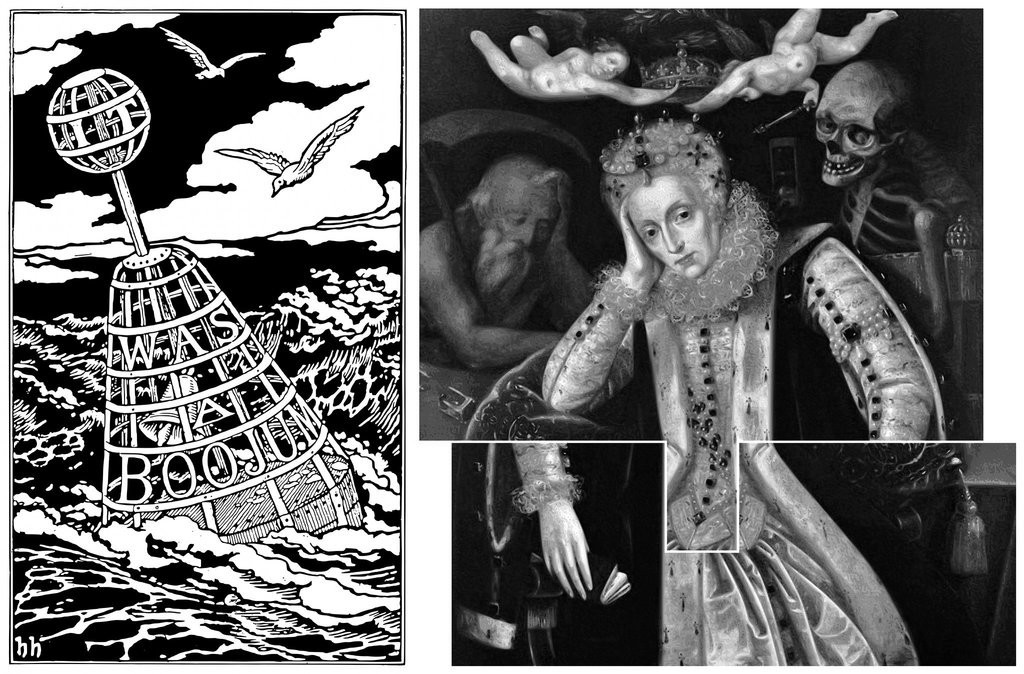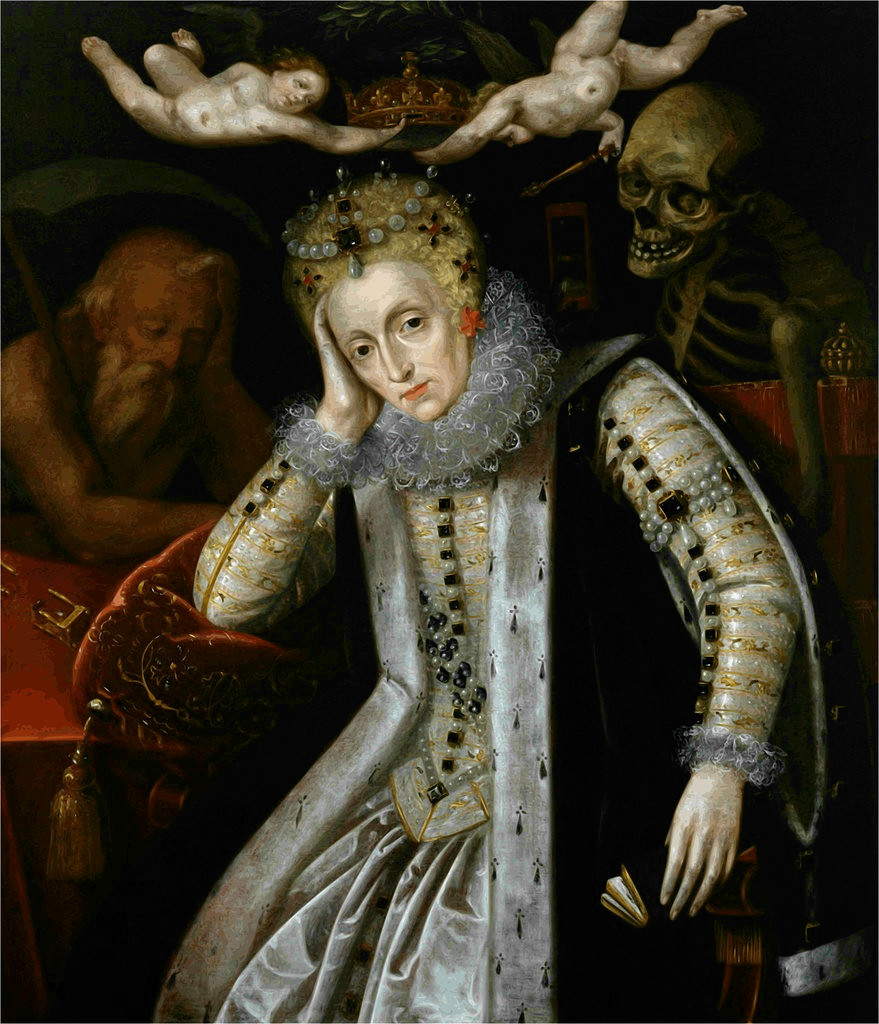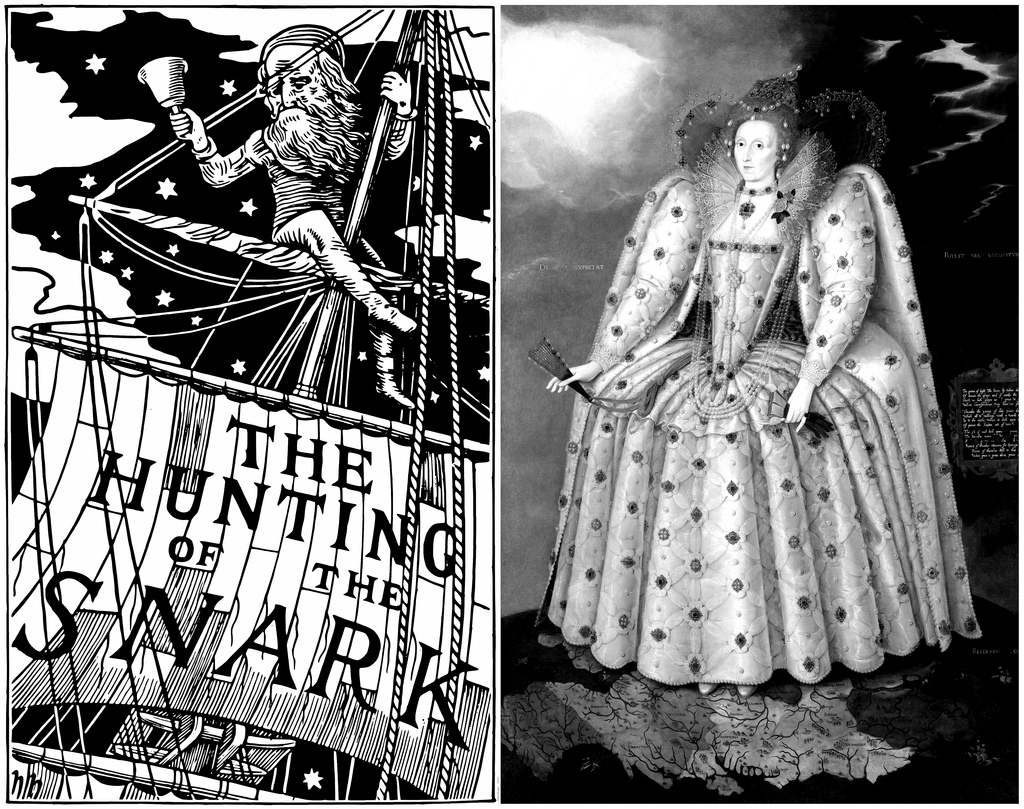- [left]: Henry Holiday’s illustration (1876) to the front cover of Lewis Carroll’s The Hunting of the Snark
[right]: A grey shaded reproduction of the Ditchley Portrait (a gift from Sir Henry Lee to Queen Elizabeth I, c. 1592) by Marcus Gheeraerts the Younger.
For the gloves and the fan see also: Alice’s Adventures in Wonderland. (Admittedly, the Queen’s gloves are not white. For yellow gloves you have to go to The Hunting of the Snark.)
John Tufail’s The Illuminated Snark lead me to this comparison (and to another comparison much later in 2024). He interpreted the starry night sky in the Snark front cover illustration as a map. And I already found out, that Holiday alluded to artwork by Marcus Gheeraerts (the younger and the elder). So I searched for a Gheeraerts painting with a map. That guided me to the Ditchley Portrait. (It took a few years until that also guided me to another map.)
When the queen met the Boojum:

- [left]: Henry Holiday’s back cover illustration (1876) to Lewis Carroll’s The Hunting of the Snark.
- [right]: Rearranged allegorical English School painting (by an unknown artist, ca. 1610) of Queen Elizabeth I at Old Age with allegory of Death and Father Time.
 (EAN: 4050356835081. Location of original painting: Corsham Court, Wiltshire, England, UK)
(EAN: 4050356835081. Location of original painting: Corsham Court, Wiltshire, England, UK)
Changes to lower segment: mirror view.
www.corsham-court.co.uk/Pictures/Commentary.html says:
“This portrait of Elizabeth I illustrates the difficulties she encountered during her troubled reign. For example, conflict between Protestants and Catholics was rife and the re-drafting of the Book of Common Prayer (held in her left hand, here – in mirror view – in the right hand) was a sensitive issue of the time.”
Another comment by Gareth Russell in Natalie Grueninger‘s blog (http://onthetudortrail.com/Blog/2014/11/01/portrait-of-an-ageing-elizabeth-i-by-gareth-russell/, 2014-11-01):
“My first introduction to the painting was years ago via a caption which said the artist was trying to mock Elizabeth’s pretensions to eternal youth. As an act of defiance, once she was safely dead, she was painted withered and frail, hemmed in by the two forces which no amount of air-brushing could save her from. However, I’m not so sure that is the intention. We know so little about its providence that the aforementioned theory about its message might tell us far more about the twentieth century author of the caption than the seventeenth century artist. Instead, there seems to me to be something rather tender about it. The skeletal figure of Death who hovers over the Queen’s shoulder makes more sense as a revived danse macabre than as a ghoulish game of point-settling.”
From the Catalogue of the Pictures at Corsham Court (1939) by Tancred Burenius I learned that the painting was owned by Paul Methuen since 1765. According to the catalogue, there was a note among the Corsham family papers saying that this picture was painted for Queen Elizabeth at c. 1600 by her express desire after the condemnation of the Earl of Essex.
related blog post | Father Time | Instagram | asemic writing in the waves?
2019-02-07: On Alamy someone tries to use the images commercially: Alamy (Image ID: MMX3GT). Also Image ID’s MYEGA6, MX7WYC and MWC44E are hosted by Alamy. Don’t buy the images from them. You can download them from this Snark blog.
2017-09-30, update: 2025-05-05


 (EAN: 4050356835081. Location of original painting: Corsham Court, Wiltshire, England, UK)
(EAN: 4050356835081. Location of original painting: Corsham Court, Wiltshire, England, UK)